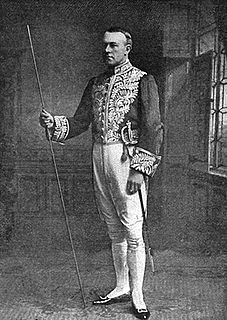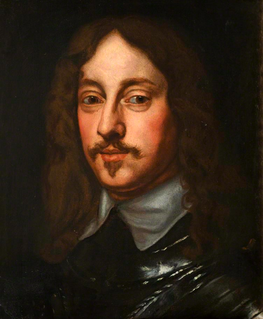 W
WThe Lord Great Chamberlain of England is the sixth of the Great Officers of State, ranking beneath the Lord Privy Seal and above the Lord High Constable. The Lord Great Chamberlain has charge over the Palace of Westminster.
 W
WRobert Bertie, 4th Duke of Ancaster and Kesteven, PC, styled Lord Robert Bertie until 1758 and Marquess of Lindsey between 1758 and 1778, was a British peer. He was born in Grimsthorpe, the second son of the General Peregrine Bertie, 3rd Duke of Ancaster and Kesteven and Mary Panton
 W
WPeregrine Bertie, 2nd Duke of Ancaster and Kesteven, styled The Honourable Peregrine Bertie between 1686 and 1704, Lord Willoughby de Eresby between 1704 and 1715 and Marquess of Lindsey between 1715 and 1723, was a British politician who sat in the House of Commons from 1708 until 1715 when he was called to the House of Lords.
 W
WGeneral Peregrine Bertie, 3rd Duke of Ancaster and Kesteven, styled Lord Willoughby de Eresby from 1715 to 1723 and Marquess of Lindsey from 1735 to 1742 was the son of Peregrine Bertie, 2nd Duke of Ancaster and Kesteven.
 W
WRobert Bertie, 1st Duke of Ancaster and Kesteven PC, styled 17th Baron Willoughby de Eresby between 1666 and 1701, and known as 4th Earl of Lindsey between 1701 and 1706, and as 1st Marquess of Lindsey between 1706 and 1715, was a British statesman and nobleman.
 W
WJohn Beaumont, 1st Viscount Beaumont, was an English nobleman and magnate from Folkingham, Lincolnshire. He was a councillor to King Henry VI and was rewarded for his services, becoming a leading member of the East Anglian nobility. Beaumont held numerous offices for the crown, and was promoted up the peerage to become the first man with the rank of viscount. He also amassed immense personal wealth, acquired through inheritance, marriage, and royal patronage.
 W
WDavid George Philip Cholmondeley, 7th Marquess of Cholmondeley, ( CHUM-lee; born 27 June 1960; styled Viscount Malpas from birth until 1968, and subsequently Earl of Rocksavage until 1990) is a British peer and filmmaker. He also acts as Lord Great Chamberlain of the United Kingdom.
 W
WGeorge Henry Hugh Cholmondeley, 4th Marquess of Cholmondeley was a British peer and a hereditary joint Lord Great Chamberlain of England. He exercised the office of Lord Great Chamberlain during the reign of King Edward VII (1901–1910).
 W
WGeorge Horatio Charles Cholmondeley, 5th Marquess of Cholmondeley, styled Earl of Rocksavage from birth until 1923, was a British peer. He was the Lord Great Chamberlain of England in 1936 and also between 1952 and 1966.
 W
WGeorge Hugh Cholmondeley, 6th Marquess of Cholmondeley,, , (CHUM-lee); 24 April 1919 – 13 March 1990), styled Earl of Rocksavage from 1923 until 1968, was a British peer who served as Lord Great Chamberlain of England between 1968 and 1990.
 W
WThomas Cromwell, 1st Earl of Essex, was an English lawyer and statesman who served as chief minister to King Henry VIII from 1534 to 1540, when he was beheaded on orders of the king.
 W
WRobert de Vere, Duke of Ireland, Marquess of Dublin, and 9th Earl of Oxford KG was a favourite and court companion of King Richard II of England. He was the ninth Earl of Oxford and the first and only Duke of Ireland and Marquess of Dublin.
 W
WMontagu Bertie, 2nd Earl of Lindsey, KG, PC was an English soldier, courtier, and politician who sat in the House of Commons between 1624 and 1626. He was created Baron Willoughby de Eresby by writ of acceleration in 1640 and inherited the peerage of Earl of Lindsey in 1642. He fought in the Royalist army in the English Civil War.
 W
WWilliam Parr, 1st Marquess of Northampton, 1st Earl of Essex, 1st Baron Parr, was the only brother of Queen Catherine Parr, the sixth and final wife of King Henry VIII. He was a "sincere, plain, direct man, not crafty nor involved", whose "delight was music and poetry and his exercise war" who co-authored a treatise on hare coursing. He was in favour with the first two successive Protestant Tudor monarchs, Henry VIII and his son Edward VI, under whom he was the leader of the Protestant party, but having supported the desire of the latter to be succeeded by the Protestant Lady Jane Grey, was attainted by the Catholic Queen Mary, but was restored by her half-sister and Protestant successor Queen Elizabeth I. He married thrice but died without issue.
 W
WJohn Dudley, 1st Duke of Northumberland was an English general, admiral, and politician, who led the government of the young King Edward VI from 1550 until 1553, and unsuccessfully tried to install Lady Jane Grey on the English throne after the King's death. The son of Edmund Dudley, a minister of Henry VII executed by Henry VIII, John Dudley became the ward of Sir Edward Guildford at the age of seven. Dudley grew up in Guildford's household together with his future wife, Guildford's daughter Jane, with whom he was to have 13 children. Dudley served as Vice-Admiral and Lord Admiral from 1537 until 1547, during which time he set novel standards of navy organisation and was an innovative commander at sea. He also developed a strong interest in overseas exploration. Dudley took part in the 1544 campaigns in Scotland and France and was one of Henry VIII's intimates in the last years of the reign. He was also a leader of the religious reform party at court.
 W
WAubrey de Vere, 10th Earl of Oxford was the third son of John de Vere, 7th Earl of Oxford and Maud de Badlesmere, daughter of Bartholomew de Badlesmere, 1st Lord Badlesmere.
 W
WEdward de Vere, 17th Earl of Oxford was an English peer and courtier of the Elizabethan era. Oxford was heir to the second oldest earldom in the kingdom, a court favourite for a time, a sought-after patron of the arts, and noted by his contemporaries as a lyric poet and court playwright, but his volatile temperament precluded him from attaining any courtly or governmental responsibility and contributed to the dissipation of his estate.
 W
WJohn de Vere, 15th Earl of Oxford, Lord Great Chamberlain KG PC was an English peer and courtier.
 W
WEdward Seymour, 1st Duke of Somerset PC, also known as Edward Semel, was the eldest surviving brother of Queen Jane Seymour (d. 1537), the third wife of King Henry VIII. He was Lord Protector of England from 1547 to 1549 during the minority of his nephew King Edward VI (1547–1553). Despite his popularity with the common people, his policies often angered the gentry and he was overthrown.